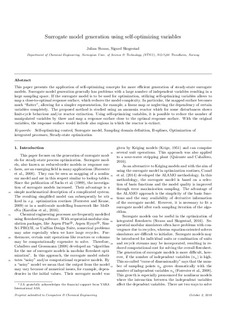| dc.contributor.author | Straus, Julian | |
| dc.contributor.author | Skogestad, Sigurd | |
| dc.date.accessioned | 2019-03-20T14:51:59Z | |
| dc.date.available | 2019-03-20T14:51:59Z | |
| dc.date.created | 2018-09-25T10:28:53Z | |
| dc.date.issued | 2018 | |
| dc.identifier.citation | Computers and Chemical Engineering. 2018, 119 (2), 143-151. | nb_NO |
| dc.identifier.issn | 0098-1354 | |
| dc.identifier.uri | http://hdl.handle.net/11250/2590929 | |
| dc.description.abstract | This paper presents the application of self-optimizing concepts for more efficient generation of steady-state surrogate models. Surrogate model generation generally has problems with a large number of independent variables resulting in a large sampling space. If the surrogate model is to be used for optimization, utilizing self-optimizing variables allows to map a close-to-optimal response surface, which reduces the model complexity. In particular, the mapped surface becomes much “flatter”, allowing for a simpler representation, for example, a linear map or neglecting the dependency of certain variables completely. The proposed method is studied using an ammonia reactor which for some disturbances shows limit-cycle behaviour and/or reactor extinction. Using self-optimizing variables, it is possible to reduce the number of manipulated variables by three and map a response surface close to the optimal response surface. With the original variables, the response surface would include also regions in which the reactor is extinct. | nb_NO |
| dc.language.iso | eng | nb_NO |
| dc.publisher | Elsevier | nb_NO |
| dc.rights | Attribution-NonCommercial-NoDerivatives 4.0 Internasjonal | * |
| dc.rights.uri | http://creativecommons.org/licenses/by-nc-nd/4.0/deed.no | * |
| dc.title | Surrogate model generation using self-optimizing variables | nb_NO |
| dc.type | Journal article | nb_NO |
| dc.type | Peer reviewed | nb_NO |
| dc.description.version | acceptedVersion | nb_NO |
| dc.source.pagenumber | 143-151 | nb_NO |
| dc.source.volume | 119 | nb_NO |
| dc.source.journal | Computers and Chemical Engineering | nb_NO |
| dc.source.issue | 2 | nb_NO |
| dc.identifier.doi | 10.1016/j.compchemeng.2018.08.031 | |
| dc.identifier.cristin | 1613249 | |
| dc.relation.project | Norges forskningsråd: 257632 | nb_NO |
| dc.description.localcode | © 2018. This is the authors’ accepted and refereed manuscript to the article. Locked until 25.8.2020 due to copyright restrictions. This manuscript version is made available under the CC-BY-NC-ND 4.0 license http://creativecommons.org/licenses/by-nc-nd/4.0/ | nb_NO |
| cristin.unitcode | 194,66,30,0 | |
| cristin.unitname | Institutt for kjemisk prosessteknologi | |
| cristin.ispublished | true | |
| cristin.fulltext | postprint | |
| cristin.qualitycode | 2 | |

